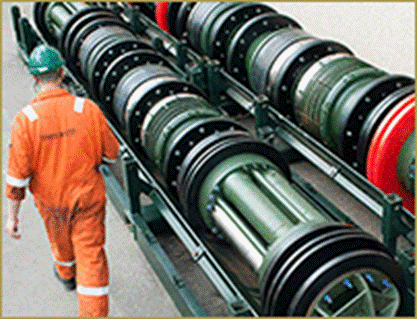- Deepwater Operations: As oil and gas reserves continue to decline in shallower waters, subsea engineers are increasingly operating in deep and challenging environments. This requires new and innovative technologies to ensure the safe and efficient operation of subsea equipment.
- Extreme water depth: the technical and operational difficulties of operating at great depths.
- Subsea infrastructure: the design and deployment of subsea infrastructure, including pipelines, umbilicals, and subsea equipment.
- Remote operations: managing remote subsea operations, including monitoring, maintenance, and repair.
- Real-time data: collecting and analysing real-time data to inform decision-making and improve operations.
- Robust communication: establishing and maintaining robust communication systems for subsea operations.
- Regulatory compliance: complying with regulations and standards, such as those set by the IMO and OGP.
- Technological innovation: keeping up with technological innovations and advancements in subsea engineering.
- Decommissioning: planning and executing the decommissioning of subsea infrastructure, including pipelines and wells.
- Collaboration: fostering effective collaboration between subsea engineers, operators, and other stakeholders.
- Risk management: managing risks associated with subsea operations, including safety, environmental, and financial risks.
- Decommissioning and Abandonment: With many subsea assets reaching the end of their operational lives, subsea engineers face the challenge of safely and efficiently decommissioning and abandoning these assets.
- Technological advancements: leveraging new technologies, such as robotics, automation, and artificial intelligence, to enhance the efficiency and safety of decommissioning operations.
- Environmental concerns: addressing increasing environmental concerns and regulations related to oil rig decommissioning.
- Cost reduction: finding ways to reduce the costs of decommissioning, including reuse and recycling of materials.
- Increased collaboration: fostering increased collaboration between oil companies, regulators, and environmental groups to drive better outcomes for all stakeholders.
- Decommissioning planning: integrating decommissioning planning into the design and construction of new oil rigs to minimize future costs and environmental impacts.
- Offshore wind: considering opportunities to repurpose decommissioned oil rigs for offshore wind energy production.
- Renewable energy: exploring the potential of decommissioned oil rigs as sites for renewable energy production, such as wave and tidal energy.
- Data management: improving data management and sharing to enhance transparency and collaboration in the decommissioning process.
- Public perception: improving public perception of decommissioning activities and addressing public concerns related to environmental impacts and costs.
- International cooperation: promoting international cooperation to standardize decommissioning practices and reduce costs and environmental impacts.
- Increasing Complexity: With the increasing sophistication of subsea systems, subsea engineers must stay up to date with the latest technologies and design practices to ensure the safe and efficient operation of these systems.
- Integration of new technologies: incorporating new technologies, such as artificial intelligence, big data analytics, and the Internet of Things, into subsea systems.
- Remote operations: increasing the use of remote operations and autonomous systems to enhance the efficiency and safety of subsea activities.
- Cybersecurity: addressing the increasing threat of cyber-attacks on subsea systems and ensuring their security and reliability.
- Maintenance and repair: developing new methods for the maintenance and repair of subsea systems, including the use of robotics and autonomous vehicles.
- Data management: improving data management and analysis to enhance decision-making and performance optimization in subsea systems.
- Collaboration: fostering increased collaboration and knowledge sharing among stakeholders in the subsea industry to drive innovation and efficiency.
- Subsea digital twin: utilising subsea digital twin technology to simulate and optimise subsea systems and operations.
- Integration of renewable energy: exploring the integration of renewable energy sources, such as wave and tidal energy, into subsea systems.
- Deepwater exploration: expanding deepwater exploration and production activities, including the development of new technologies and systems to support these operations.
- Regulatory compliance: complying with increasingly complex and stringent regulations related to subsea systems and operations.
- Cost Management: With the ongoing challenges faced by the oil and gas industry, subsea engineers must find ways to reduce costs while maintaining safety and operational efficiency.
- Technological advancements: leveraging new technologies, such as robotics, automation, and artificial intelligence, to reduce costs and increase efficiency in subsea engineering.
- Integrated project planning: incorporating cost management into the planning and design phase of subsea engineering projects to reduce costs and mitigate risks.
- Data analytics: utilising data analytics to improve decision-making and optimise cost management in subsea engineering.
- Supply chain management: optimising supply chain management to reduce costs and improve the efficiency of subsea engineering projects.
- Collaboration: fostering increased collaboration among stakeholders in the subsea industry to drive innovation, reduce costs, and optimise performance.
- Standardisation: promoting standardisation of subsea engineering practices and technologies to reduce costs and improve efficiency.
- Life cycle management: integrating life cycle management into subsea engineering projects to optimise cost and performance over the life of the infrastructure.
- Decommissioning planning: incorporating decommissioning and abandonment planning into subsea engineering projects to minimize future costs and improve cost management.
- Risk management: incorporating risk management into cost management processes to mitigate risks and reduce costs.
- Cost transparency: increasing cost transparency and reporting to improve accountability and cost management in subsea engineering.
- Environmental Protection: As public concern over the environmental impact of offshore activities grows, subsea engineers must find ways to minimise the impact of their operations and ensure compliance with regulations and industry standards.
- Minimising the impact of subsea operations on marine life and habitat
- Reducing greenhouse gas emissions from subsea equipment and vessels
- Proper disposal of subsea waste and materials
- Prevention of oil spills and other forms of pollution
- Minimising noise pollution from subsea equipment and vessels
- Protecting sensitive and vulnerable areas, such as coral reefs and deep-sea habitats.
Subsea engineers play a critical role in the exploration and production of oil and gas, and these challenges highlight the need for ongoing training and development to ensure the safe and efficient operation of subsea systems.


.png)
.png)
-1.png)

